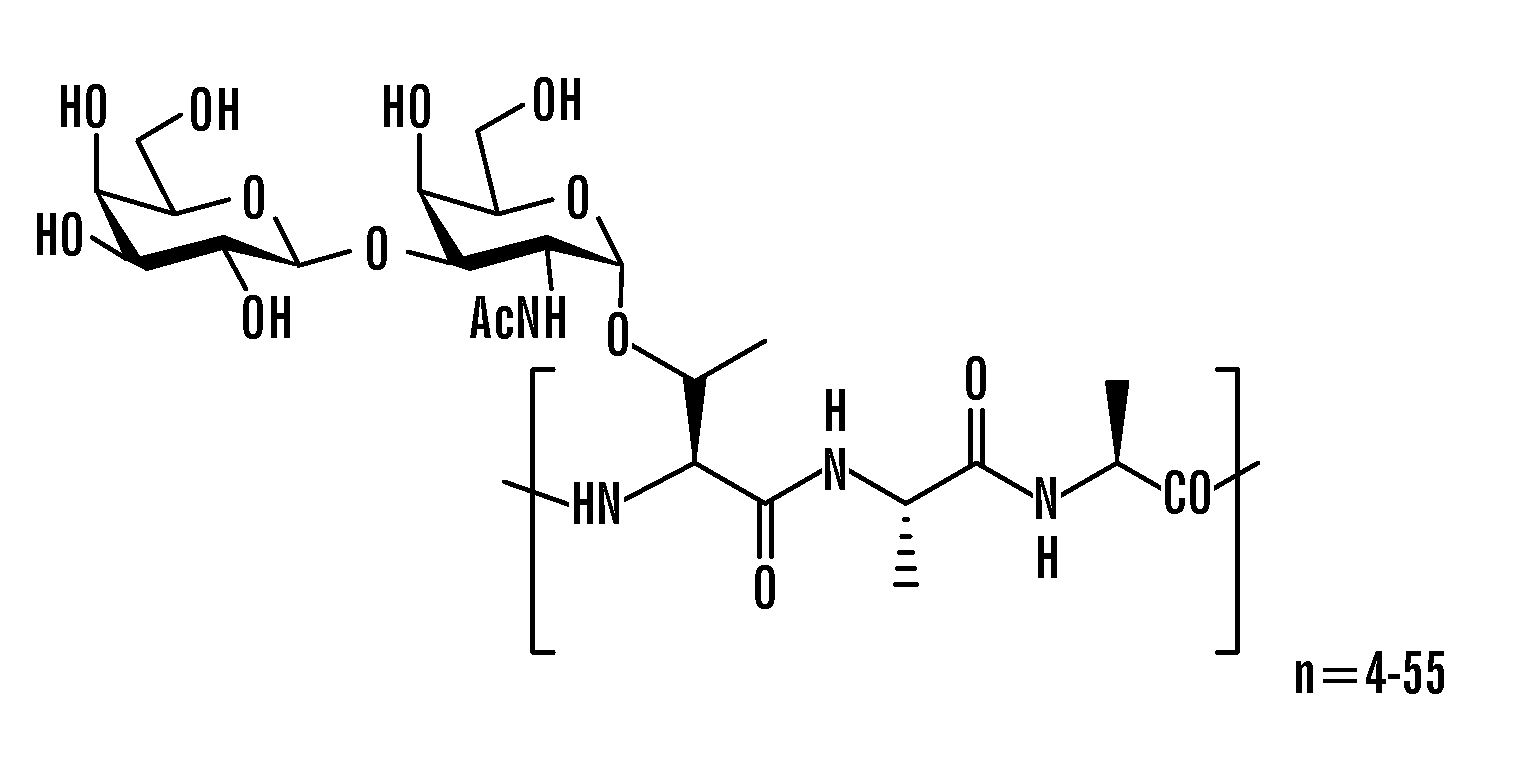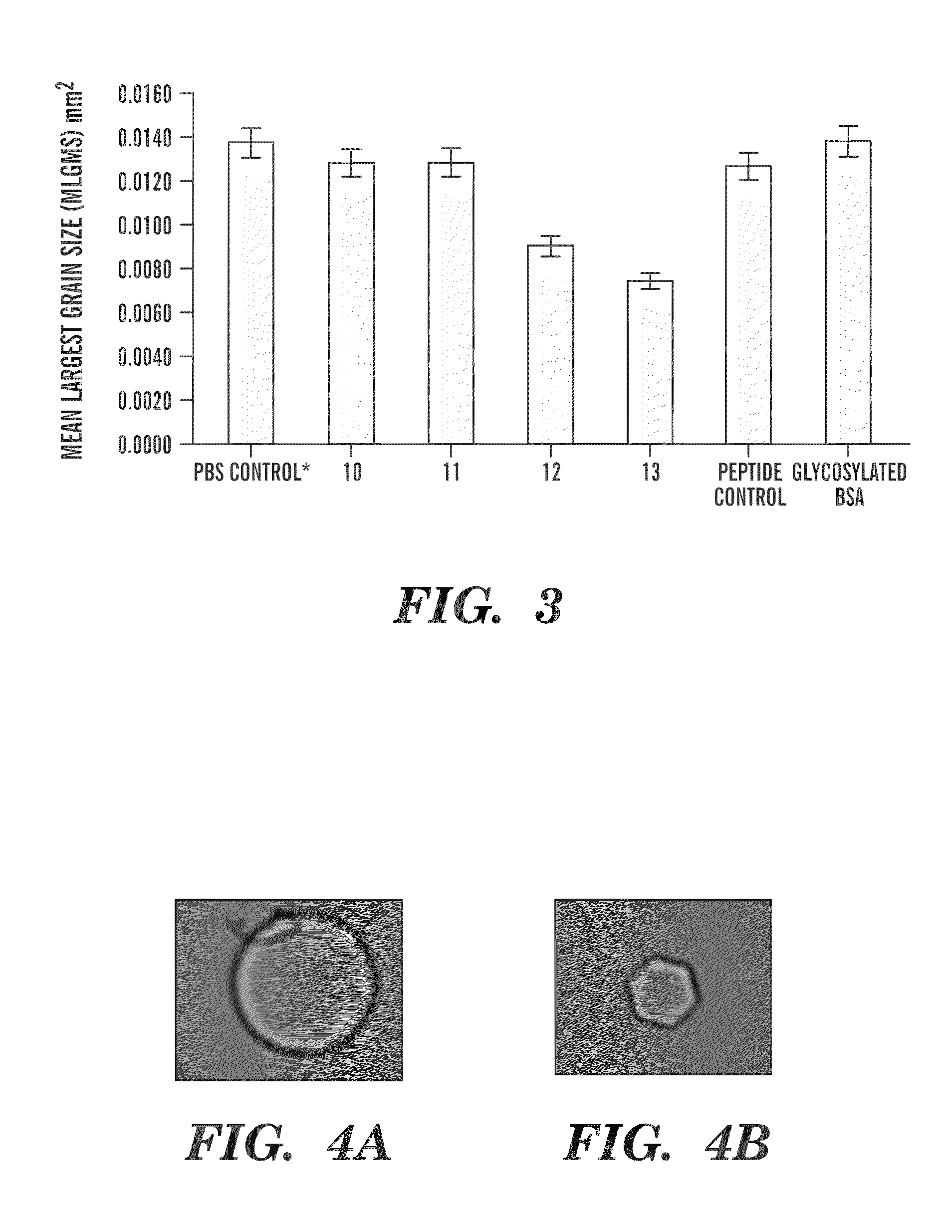Antifreeze glycoprotein analogues and uses thereof
a glycoprotein and antifreeze technology, applied in the field of synthetic antifreeze glycoprotein analogues, can solve the problems of complex glycans that require lengthy and costly syntheses, and achieve the effects of inhibiting recrystallization, and improving the texture of processed frozen food
- Summary
- Abstract
- Description
- Claims
- Application Information
AI Technical Summary
Benefits of technology
Problems solved by technology
Method used
Image
Examples
experiment 1
Synthesis of Structural Mimics of AFGPs
[0078]A general synthetic strategy was developed to prepare structural mimics of AFGPs (FIG. 2). The approach is centered on the synthesis of glycosylated tripeptide building blocks that are assembled using conventional solid phase synthesis. This approach differs from previous ones in that C-linked glycoconjugates are utilized. As a consequence, enhanced stability is obtained since C-linked glycoconjugates are not susceptible to acid / base or enzyme-mediated hydrolysis.
[0079]Synthesis of the glycosylated tripeptide building block is convergent in that saccharide and tripeptide components are covalently attached in a final step. Since early chemical and enzymatic modification of native AFGP (Komatsu, S. K. D., A. L.; Feeney, R. E., J. Biol. Chem. 1970, 245, 2909; Feeney, R. E. Y., Y., Adv. Protein Chem. 1978, 32, 191) demonstrated that the terminal galactose residue was crucial for activity, efforts have been focused on AFGP mimics that possess ...
experiment 2
Hydration Index of a Carbohydrate and Correlation to RI Activity
[0144]Carbohydrates are prolific in biological systems and are involved in many processes ranging from cellular adhesion, cell signaling, infection and regulation of the immune response (Cheng, C. C.; Bennett, D. Cell 1980, 19, 537-543; Grabel, L. B.; Rosen, S. D.; Martin, G. R. Cell 1979, 17, 477-484; Stanley, P.; Sudo, T. Cell, 1981, 23, 763-769; Neufeld, E.; Ashwell, G. In Biochemistry of Glycoproteins and Proteoglycans. W. J. Lennarz, ed. (New York: Plenum Press), 1980; p 241-266). In addition, carbohydrates are involved in the cryoprotection of organisms inhabiting cold climates (Yeh, Y.; Feeney, R. E. Chem. Rev. 1996, 96, 601).
[0145]It is well accepted that hydration of proteins plays an important role in modulating protein function (Frauenfelder, H.; Fenimore, P. W.; McMahon, B. H. Biophys. Chem. 2002, 98, 35-48). Similarly, hydration or solvation of carbohydrates or oligosaccharides temper their biological activ...
experiment 3
Conformation of C-Linked Antifreeze Glycoprotein Analogues and Its Effect on Antifreeze Activity
[0172]As shown above, a series of AFGP analogues have been prepared and shown to posses a high degree of ice recrystallization-inhibition activity (RI) and no thermal hysteresis. Analogues 2 and 3 (below) are two such inhibitors. The notion that these compounds may function as effective cryoprotectants is further exemplified by the fact that analogue 3 has been shown to exhibit little or no in vitro cytotoxicity, can penetrate cells and also inhibits cold-induced apoptotic cell death. The current experiment explores how decreasing the length of the amide-containing side chain influences antifreeze activity and how subtle changes in conformation of the side chain and carbohydrate affect the ability of these compounds to inhibit ice recrystallization.
Material and Methods:
General Experimental:
[0173]All anhydrous reactions were performed in flame-dried glassware under a positive pressure of d...
PUM
| Property | Measurement | Unit |
|---|---|---|
| Fraction | aaaaa | aaaaa |
| Fraction | aaaaa | aaaaa |
| Fraction | aaaaa | aaaaa |
Abstract
Description
Claims
Application Information
 Login to View More
Login to View More - R&D
- Intellectual Property
- Life Sciences
- Materials
- Tech Scout
- Unparalleled Data Quality
- Higher Quality Content
- 60% Fewer Hallucinations
Browse by: Latest US Patents, China's latest patents, Technical Efficacy Thesaurus, Application Domain, Technology Topic, Popular Technical Reports.
© 2025 PatSnap. All rights reserved.Legal|Privacy policy|Modern Slavery Act Transparency Statement|Sitemap|About US| Contact US: help@patsnap.com



